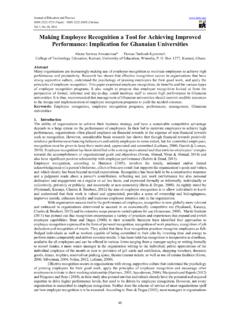Transcription of Improved Training of Wasserstein GANs
1 Improved Training of Wasserstein GANsIshaan Gulrajani1 , Faruk Ahmed1, Martin Arjovsky2, Vincent Dumoulin1, Aaron Courville1,31 Montreal Institute for Learning Algorithms2 Courant Institute of Mathematical Sciences3 CIFAR Adversarial Networks (GANs) are powerful generative models, butsuffer from Training instability. The recently proposed Wasserstein GAN (WGAN)makes progress toward stable Training of GANs, but sometimes can still generateonly poor samples or fail to converge. We find that these problems are often dueto the use of weight clipping in WGAN to enforce a Lipschitz constraint on thecritic, which can lead to undesired behavior.
2 We propose an alternative to clippingweights: penalize the norm of gradient of the critic with respect to its input. Ourproposed method performs better than standard WGAN and enables stable train-ing of a wide variety of GAN architectures with almost no hyperparameter tuning,including 101-layer ResNets and language models with continuous also achieve high quality generations on CIFAR-10 and LSUN bedrooms. 1 IntroductionGenerative Adversarial Networks (GANs) [9] are a powerful class of generative models that castgenerative modeling as a game between two networks: a generator network produces synthetic datagiven some noise source and a discriminator network discriminates between the generator s outputand true data.
3 GANs can produce very visually appealing samples, but are often hard to train, andmuch of the recent work on the subject [23, 19, 2, 21] has been devoted to finding ways of stabilizingtraining. Despite this, consistently stable Training of GANs remains an open particular, [1] provides an analysis of the convergence properties of the value function beingoptimized by GANs. Their proposed alternative, named Wasserstein GAN (WGAN) [2], leveragesthe Wasserstein distance to produce a value function which has better theoretical properties than theoriginal.
4 WGAN requires that the discriminator (called thecriticin that work) must lie within thespace of 1-Lipschitz functions, which the authors enforce through weight contributions are as follows:1. On toy datasets, we demonstrate how critic weight clipping can lead to undesired We proposegradient penalty (WGAN-GP), which does not suffer from the same We demonstrate stable Training of varied GAN architectures, performance improvementsover weight clipping, high-quality image generation, and a character-level GAN languagemodel without any discrete sampling.
5 Now at Google Brain Code for our models is available [ ] 25 Dec 20172 Generative adversarial networksThe GAN Training strategy is to define a game between two competing networks. Thegeneratornetwork maps a source of noise to the input space. Thediscriminatornetwork receives either agenerated sample or a true data sample and must distinguish between the two. The generator istrained to fool the , the game between the generatorGand the discriminatorDis the minimax objective:minGmaxDEx Pr[log(D(x))] +E x Pg[log(1 D( x))],(1)wherePris the data distribution andPgis the model distribution implicitly defined by x=G(z),z p(z)(the inputzto the generator is sampled from some simple noise distributionp, such as the uniform distribution or a spherical Gaussian distribution).
6 If the discriminator is trained to optimality before each generator parameter update, then minimiz-ing the value function amounts to minimizing the Jensen-Shannon divergence betweenPrandPg[9], but doing so often leads to vanishing gradients as the discriminator saturates. In practice, [9]advocates that the generator be instead trained to maximizeE x Pg[log(D( x))], which goes someway to circumvent this difficulty. However, even this modified loss function can misbehave in thepresence of a good discriminator [1]. Wasserstein GANs[2] argues that the divergences which GANs typically minimize are potentially not continuous withrespect to the generator s parameters, leading to Training difficulty.
7 They propose instead usingtheEarth-Mover(also called Wasserstein -1) distanceW(q,p), which is informally defined as theminimum cost of transporting mass in order to transform the distributionqinto the distributionp(where the cost is mass times transport distance). Under mild assumptions,W(q,p)is continuouseverywhere and differentiable almost WGAN value function is constructed using the Kantorovich-Rubinstein duality [25] to obtainminGmaxD DEx Pr[D(x)] E x Pg[D( x))](2)whereDis the set of 1-Lipschitz functions andPgis once again the model distribution implicitlydefined by x=G(z),z p(z).
8 In that case, under an optimal discriminator (called acriticin thepaper, since it s not trained to classify), minimizing the value function with respect to the generatorparameters minimizesW(Pr,Pg).The WGAN value function results in a critic function whose gradient with respect to its input isbetter behaved than its GAN counterpart, making optimization of the generator easier. Empirically,it was also observed that the WGAN value function appears to correlate with sample quality, whichis not the case for GANs [2].To enforce the Lipschitz constraint on the critic, [2] propose to clip the weights of the critic to liewithin a compact space [ c,c].
9 The set of functions satisfying this constraint is a subset of thek-Lipschitz functions for somekwhich depends oncand the critic architecture. In the followingsections, we demonstrate some of the issues with this approach and propose an Properties of the optimal WGAN criticIn order to understand why weight clipping is problematic in a WGAN critic, as well as to motivateour approach, we highlight some properties of the optimal critic in the WGAN framework. We provethese in the two distributions inX, a compact metric space.
10 Then, there is a1-Lipschitz functionf which is the optimal solution ofmax f L 1Ey Pr[f(y)] Ex Pg[f(x)].Let be the optimal coupling betweenPrandPg, defined as the minimizer of:W(Pr,Pg) =inf (Pr,Pg)E(x,y) [ x y ]where (Pr,Pg)is the set of joint distributions (x,y)whosemarginals arePrandPg, respectively. Then, iff is differentiable , (x=y) = 0 , andxt=tx+ (1 t)ywith0 t 1, it holds thatP(x,y) [ f (xt) =y xt y xt ]= has gradient norm 1 almost everywhere Difficulties with weight constraintsWe find that weight clipping in WGAN leads to optimization difficulties, and that even when op-timization succeeds the resulting critic can have a pathological value surface.
![arXiv:0706.3639v1 [cs.AI] 25 Jun 2007](/cache/preview/4/1/3/9/3/1/4/b/thumb-4139314b93ef86b7b4c2d05ebcc88e46.jpg)

![arXiv:1301.3781v3 [cs.CL] 7 Sep 2013](/cache/preview/4/d/5/0/4/3/4/0/thumb-4d504340120163c0bdf3f4678d8d217f.jpg)
![@google.com arXiv:1609.03499v2 [cs.SD] 19 Sep 2016](/cache/preview/c/3/4/9/4/6/9/b/thumb-c349469b499107d21e221f2ac908f8b2.jpg)











